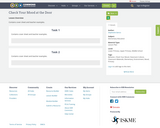
Contains cover sheet and teacher examples.
- Subject:
- Elementary Education
- Material Type:
- Lesson Plan
- Author:
- Stephanie Genco
- Date Added:
- 05/22/2019

Contains cover sheet and teacher examples.

Contains tool overview and student work sample

Im Rahmen der Erstellung von MuxBooks(Multimedia User Experience Books) erwerben Schüler:innendiverse Fach-, Sprach-und Sozial-Kompetenzen.Auch werden zahlreiche digitale Kompetenzen gefördert: Produktion und Präsentation, Problemlösen und Handeln, Information und Recherche, Kommunikation und Kooperation, Analyse und Reflexion.
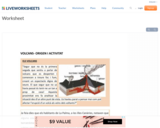
GEOGRAFIA I HISTORIA - 1er ESO

The purpose of Design Dilemma is to encourage students to use resourceful and creative behaviors to think like a scientist. Students will demonstrate these behaviors to design and build a suitable structure for a fourth little pig. Although the use of the book The Fourth Little Pig is helpful, the module may be taught without it. This module is meant for all students. The classroom teacher should work with a specialist or special educator to find or develop alternate activities or resources for visually impaired students, where appropriate.

OverviewThe purpose of Thinking Big is to immerse students in a series of research-based cognitive behaviors that are foundational to school and life success: creativity, logical reasoning, memory, and spatial reasoning.Thinking Big was developed by Frederick County Public Schools and is made up of single-day experiences designed to instruct students in the behaviors and elicit them without additional prompting. While arranged in order of difficulty, lessons may also serve as “stand-alone” experiences throughout the year grouped by cognitive focus. Most lessons use mathematical thinking prompts and manipulatives. The focus of the unit is not on math, but on thinking and reasoningThe lessons have also been mapped to the relevant gifted behaviors that are taught and observed through the PTD Program. There are two scoring guides: one that allows the observer to record the names of those students who exhibit a command of the cognitive behavior(s); and a REPI-aligned continuum, which allows the observer to note the affective behavior that undergirds a student’s high-level completion of the cognitive behavior. This module is meant for all students. The classroom teacher should work with a specialist or special educator to find or develop alternate activities or resources for visually-impaired students, where appropriate.
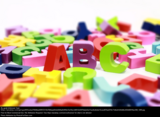
This is a mini lesson for students to learn how to draw a star by using the letter A. The lesson includes a graphic of the tutorial and a video. This would be a perfect activity for early finishers and for a substitute day.
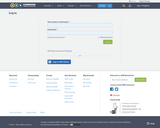
The purpose of the module, A Sense of Wonder, is to encourage students to use inquisitive and persistent behaviors as they wonder about their world. The module extends the strategies introduced in prekindergarten. These strategies include using questions to approach problems and identifying attributes to sort, classify, and make inferences. The attribute strategies serve as the foundation for subsequent Grade One and Grade Two Primary Talent Development (PTD) modules. This module is meant for all students. The classroom teacher should work with a specialist or special educator to find or develop alternate activities or resources for visually impaired students, where appropriate.
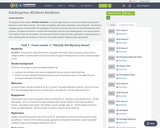
The purpose of the module, All About Attributes, is to encourage students to use communicative and perceptive behaviors to think like a scientist. The module strengthens observation, description, and sorting skills. The attribute strategies serve as the foundation for subsequent Grade One and Grade Two Primary Talent Development (PTD) modules. Throughout the lessons, students will manipulate materials, play thinking games, and create products. This module is meant for all students. The classroom teacher should work with a specialist or special educator to find or develop alternate activities or resources for visually impaired students, where appropriate.
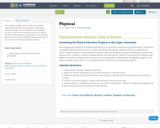
This is a Physical Education resource to be used to expand Physical Education programs to the larger community. This resource includes a downloadable document that teachers may edit and revise to match the needs of their students and program. The calendar template can be used for different months and is met to be a resource for students and their families.
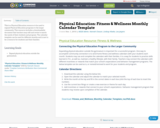
This is a Physical Education resource to be used to expand Physical Education programs to the larger community. This resource includes a downloadable document that teachers may edit and revise to match the needs of their students and program. The calendar template can be used for different months and is met to be a resource for students and their families.
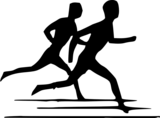
Kid-friendly visuals for students are imperative to include in your gymnasium decor. The following resource includes five seperate PDF files. Each file contains a kid friendly visual for the SHAPE America's Standards. These may be posted in your gymnasium where you see fit. Standards have been remixed from the, "National Standards & Grade Level outcomes for K-12 Physical Education," book. The Grade-Level Outcomes for K-12 Physical Education can be found here: SHAPE America
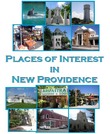
A Learning Package containing images and information on Places of Interest in New Providence. Suitable for primary level.

The purpose of the module It Fits is to encourage students to use perceptive behaviors to think like a scientist. The module introduces strategies developed in kindergarten. These strategies include identifying attributes to sort, classify, and make inferences in order to create analogies on collected observational data about our world and are for all students.

This unit is presented as a progression of tasks that allow students to explore movement through a variety of creative tasks. Students will move in personal and general space, while exploring elements of shape, size, speed, force, flow, and time. To promote student confidence and willingness in dance, teachers should isolate the dance elements before asking students to apply these elements using imagery or partner/group tasks.Photo Attribution: KCBalletMedia (Photography: Brett Pruitt & East Market Studios)References:Graham, G., Holt/Hale, S. A., & Parker, M. (2013). Children moving: A reflective approach to teaching physical education. 9th ed. New York: McGraw-Hill.Joyce, M. (1994). First steps in teaching creative dance to children. California: Mayfield Publishing.

This unit is presented as a progression of tasks that allow students to explore movement through a variety of creative tasks. Students will move in personal and general space, while exploring elements of shape, size, speed, force, flow, and time. To promote student confidence and willingness in dance, teachers should isolate the dance elements before asking students to apply these elements using imagery or partner/group tasks.The National Standards and Grade-Level Outcomes in this unit are referenced from the "National Standards & Grade Level Outcomes for K-12 Physical Education."SHAPE America Outcomes:KindergartenPerforms locomotor skills in response to teacher-led creative dance. (S1.E5.K)Maintains momentary stillness on different bases of support. (S1.E7.Ka)Forms wide, narrow, curled and twisted body shapes. (S1.E7.Kb)Contrasts the actions of curling and stretching. (S1.E10.K)Travels in general space with different speeds. (S2.E3.K)Recognizes that when you move fast, your heart beats faster and you breathe faster.3 (S3.E3.K)Follows directions in group settings (e.g., safe behaviors, following rules, taking turns). (S4.E1.K)Identifies physical activities that are enjoyable. (S5.E3.Ka)Grade OneCombines locomotor and nonlocomotor skills in a teacher- designed dance. (S1.E5.1)Maintains stillness on different bases of support with different body shapes. (S1.E7.1)Demonstrates twisting, curling, bending and stretching actions. (S1.E10.1)Differentiates between fast and slow speeds. (S2.E3.1a)Differentiates between strong and light force. (S2.E3.1b)Identifies the heart as a muscle that grows stronger with exercise, play and physical activity. (S3.E3.1)Accepts personal responsibility by using equipment and space appropriately. (S4.E1.1)Describes positive feelings that result from participating in physical activities. (S5.E3.1a)Grade TwoPerforms a teacher- and/or student- designed rhythmic activity with correct response to simple rhythms. (S1.E5.2)Balances on different bases of support, combining levels and shapes. (S1.E7.2a)Differentiates among twisting, curling, bending and stretching actions. (S1.E10.2)Combines balances and transfers into athree-part sequence (i.e., dance, gymnastics). (S1.E11.2)Varies time and force with gradual increases and decreases. (S2.E3.2)Identifies physical activities that contribute to fitness. (S3.E3.2b)Practices skills with minimal teacher prompting. (S4.E1.2)Identifies physical activities that provide self-expression (e.g. dance, gymnastics routines, practice tasks in games environments). (S5.E3.2)Photo Attribution: KCBalletMedia (Photography: Brett Pruitt & East Market Studios)References:Graham, G., Holt/Hale, S. A., & Parker, M. (2013). Children moving: A reflective approach to teaching physical education. 9th ed. New York: McGraw-Hill.Joyce, M. (1994). First steps in teaching creative dance to children. California: Mayfield Publishing.
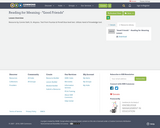
Resource by Connie Stahl, St. Aloysius. Text from Fountas & Pinnell blue level text. Utilizes Hand of Knowledge tool.

This website allows young learners to practice their coding skills. The website and app are free.
The website also provides several beginner tutorials to familiarize teachers and students with how the tools work.

Grade Level: 4th-5th GradesSubject Area: English/Language ArtsObjective/Purpose: By the end of the lesson, students will be able to differentiate between primary and secondary sources, in order to select sources appropriate for their information need/assignment.Standards Addressed- South Carolina College/Career Ready---7.1 Compare and contrast how events, topics, concepts, and ideas are depicted in primary and secondary sources.
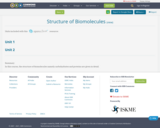
In this course, the structure of biomolecules namely carbohydrates and proteins are given in detail.